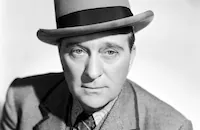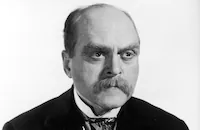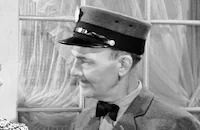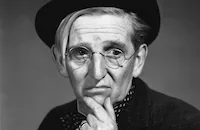Edison, the Man

Brief Synopsis
Cast & Crew
Clarence Brown
Spencer Tracy
Rita Johnson
Lynne Overman
Charles Coburn
Gene Lockhart
Film Details
Technical Specs

Synopsis
In 1929, at the Golden Jubilee of Light banquet celebrating the fiftieth anniversay of the invention of the electric lamp, Thomas Edison, the guest of honor, reflects as the toastmaster recalls his achievements: Arriving in New York as an unknown inventor, Edison tries to interest Taggart, the manager of a firm that supplies gold quotes to the board of trade, in his ideas about electricity. The shortsighted Taggart ignores the young inventor until the ticker machine breaks down and Edison repairs it. Impressed by Edison's ingenuity, General Powell, the president of Western Union, offers him a job at the Western Union workshop. There Edison is befriended by Mary Stilwell, a secretary at the company. Assisted by fellow workers Bigelow, Lundstrum and Michael Simon, Edison perfects the stock ticker and sells it to General Powell and Taggart. With the proceeds, Edison opens his own laboratory in Menlo Park, New Jersey and weds Mary. As time passes, Edison finds himself on the verge of insolvency and is about to lose his company when his friend Powell dies and he is forced to turn to Taggart for help. When Taggart insists upon total control, Edison refuses his offer and is near bankruptcy. In the nick of time, Edison invents the phonograph, which saves his lab, but he is beset by more problems when his friend, Bunt Cavatt, tells the press that he has developed an electric light. Branded as a charlatan by the scientific community, Edison strives to perfect his light invention. Enduring years of failure, Edison perseveres until he discovers incandescent light. Opposed by the gas interests led by Taggart, Edison is granted six months to prove that he can light New York City. At the last minute, Edison throws the switch to his generators and miraculously illuminates the city.

Director

Clarence Brown
Cast

Spencer Tracy

Rita Johnson

Lynne Overman

Charles Coburn

Gene Lockhart

Henry Travers

Felix Bressart

Peter Godfrey
Guy D'ennery

Byron Foulger
Milton Parsons
Arthur Aylesworth

Gene Reynolds

Addison Richards

Grant Mitchell
Paul Hurst
George Lessey
Jay Ward

Ann Gillis
Frank Faylen

Donald Douglas
Harlan Briggs
Charles Trowbridge
Harold Minjir
George Meader
Charles Waldron

Charles Lane

John Butler
Edgar Dearing
Tom Mahoney
George Ovey
George Chandler
Edward Earle
Arthur Stuart Hull
Howard Chase
Maurice Costello
Arthur Belasco
Edward Hearn
Louis Natheaux
Jack Daley
Hooper Atchley

Wilfred Lucas
Harry Humphrey

Hale Hamilton
Forbes Murray
John Dilson
Lloyd Whitlock

Jimmy Conlin

Eddie Gribbon

Emmett Vogan
Robert Winkler
Erville Alderson
Ed J. Lesaint
Cyril Ring
Billy Bletcher
Ralph Mccullough
Nick Copeland
Bruce Mitchell
Roy Cummings
Milton Kibbee
Eve Kendall
Harry C. Bradley
Michael Simms
Alex Pollard
Walter Fenner

Edward Keane
Joe Whitehead
Harry Strang
Billy Arnold
Thomas Pogue
Nell Craig
Fritzi Brunette
Helen Dickson
Crew
Clarence Brown
Hugo Butler
John W. Considine Jr.
Jack Dawn
John S. Detlie
Orville O. Dull
Bradbury Foote
Cedric Gibbons
Robert A. Golden
Talbot Jennings
Jay Marchant
Harold Rosson
Dore Schary
Douglas Shearer
William A. Simonds
Frederick Y. Smith
Norman R. Speiden
Gile Steele
Herbert Stothart
Dolly Tree
Edwin B. Willis

Photo Collections
Film Details
Technical Specs

Award Nominations
Best Original Story
Articles
Edison the Man
Considine assigned both scripts to one of MGM's brightest young writers, Dore Schary, who had won an Oscar for his original story for Boy's Town. But at first Schary had trouble finding anything screen-worthy in Edison's biographies, and their interviews with the great man's family and friend Edsel Ford didn't lead anywhere either. Finally, however, he came up with a combination of legend and fact to create a fast-moving family drama for Rooney. And by setting Edison the Man in 1929, with Edison as an old man, Schary was able to flash back to the high spots of his adult career. Given the different tones of the two films, and Rooney's and Tracy's performances, MGM added a prologue to the first film calling it merely an attempt to capture the spirit of the great man.
MGM put all of its resources behind capturing the reality of Edison the Man. Using extensive photographs and documentary footage, the art department re-created Edison's long-abandoned laboratory in Menlo Park, New Jersey, including the more than 10,000 devices he had invented. Popular Mechanics magazine lauded their efforts in a major publicity piece for the film: "Where Edison took years to make new devices workable, property men turned out a dozen of his more important inventions in a few days."
But it was star Spencer Tracy who gave the film its greatest authenticity. He started out with an advantage - a slight resemblance to the inventor. He reinforced that by studying biographies of Edison and reviewing all existing film footage of him. The one thing he didn't have to study was the man's deafness - Tracy's son John had been born deaf. The only part of his characterization that deviated from fact was substituting cigars for Edison's trademark chewing tobacco - at the request of his son Charles Edison.
Director: Clarence Brown
Producer: John W. Considine, Jr.
Screenplay: Bradbury Foote, Talbot Jennings
Story: Dore Schary, Hugo Butler
Cinematography: Harold Rosson
Art Direction: Cedric Gibbons, John S. Detlie
Music: Herbert Stothart
Principal Cast: Spencer Tracy (Thomas Edison), Rita Johnson (Mary Stillwell Edison), Lynne Overman (Bunt Cavatt), Charles Coburn (General Powell), Gene Lockhart (Mr. Taggart), Henry Travers (Mister Els). BW-108m. Close captioning.
By Frank Miller

Edison the Man
Quotes
Trivia
Notes
The working title of this picture was The Wizard of Menlo Park. According to a news item in Hollywood Reporter, H. Alan Dunn was to have co-scripted the picture, but his participation in the final project has not been confirmed. A Hollywood Reporter production chart adds Regis Toomey to the cast, but he was not in the released film. The Call Bureau Cast Service list Irving Bacon in the role of the sheriff, but that part was played by Paul Hurst. Studio publicity notes that originally M-G-M had intended to produce only one picture about Edison, but when that project proved too long, they broke the story into two parts. The first, Young Tom Edison, starred Mickey Rooney as the young Edison . Technical advisor William A. Simonds was from the Edison Institute in Dearborn, MI, and Norman R. Speiden was director of Historical Research at Thomas A. Edison, Inc. in West Orange, NJ. Dore Schary and Hugo Butler received an Academy Award nomination in the Writing (Original Story) category.















